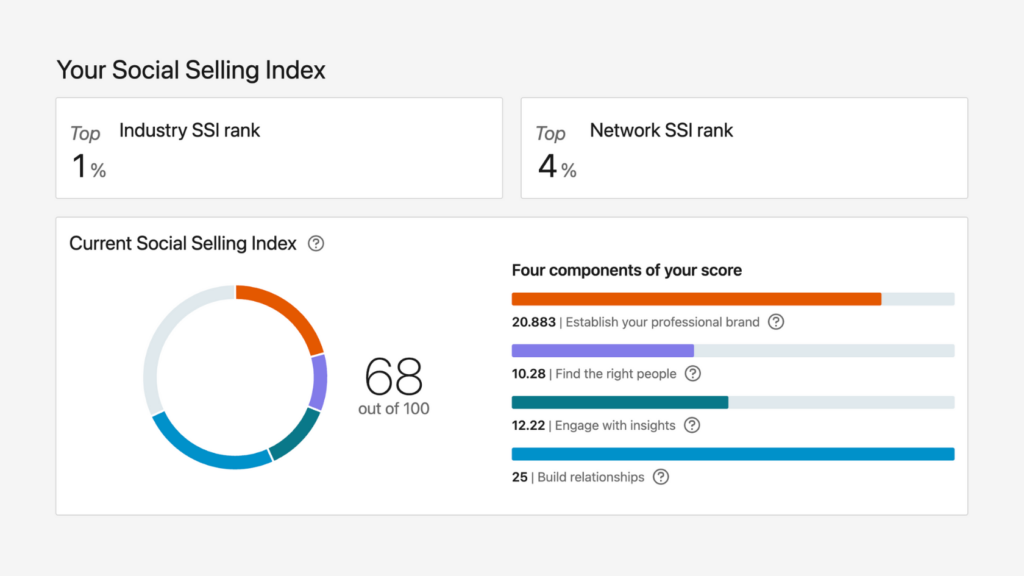In this chapter of our series, The Power of LinkedIn, we discuss how to start empowering LinkedIn analytics. Data has become an invaluable asset for businesses seeking to optimise their strategies and drive meaningful results. This holds especially true on LinkedIn, where the power of data-driven insights can unlock new opportunities for professionals and businesses alike.
Below, we delve into the power of LinkedIn analytics, exploring how harnessing the available data can propel your LinkedIn presence to new heights.
LinkedIn Analytics offers a treasure trove of information, providing valuable insights into your profile and content performance. By leveraging these insights effectively, you can refine your LinkedIn strategy, optimise your profile, and create content that resonates with your audience. Join us as we uncover the secrets to driving results with data on LinkedIn, empowering you to make informed decisions and achieve your goals on the platform.
Understanding LinkedIn Analytics
LinkedIn Analytics offers valuable insights into the performance of your profile and content. You can refine your LinkedIn strategy and maximise your impact by analysing key metrics such as profile views, post engagement, and follower demographics.
LinkedIn offers a comprehensive suite of metrics to help you track the performance of your profile and content. Understanding these metrics is essential for optimising your LinkedIn presence and achieving your goals on the platform.
Profile Views
Profile views indicate the number of times other users have viewed your LinkedIn profile. Monitoring profile views can provide insights into the visibility and reach of your profile. An increase in profile views may indicate a growing interest in your professional profile, while a decline may signal a need for optimisation or content improvement.
Connection Requests
Connection requests represent the number of users who have sent you a connection request on LinkedIn. Tracking connection requests can help you gauge the effectiveness of your networking efforts and your profile’s perceived value.
A high volume of connection requests may indicate a solid personal brand or compelling profile content.
Post Impressions
Post impressions measure the number of times other users have viewed your LinkedIn posts. This metric reflects the reach and visibility of your content on the platform. Analysing post impressions can help you understand the effectiveness of your content distribution strategy and identify opportunities for improving engagement.
Engagement Rates
Engagement rates encompass interactions with your LinkedIn content, including likes, comments, shares, and clicks. Monitoring engagement rates can provide valuable insights into the relevance and resonance of your content with your audience.
A high engagement rate indicates that your content is resonating well with your audience, while a low engagement rate may signal a need for content optimisation or refinement.
Interpreting Data Trends
Once you’ve familiarised yourself with the key metrics provided by LinkedIn Analytics, it’s essential to analyse trends in your data to uncover actionable insights and inform your strategy.
Identifying Patterns in Profile Views
Analyse trends in profile views over time to identify patterns and understand what drives interest in your profile. Look for spikes or fluctuations in profile views and correlate them with your activities on the platform.
For example, an increase in profile views may coincide with publishing a new article or participating in a relevant industry event.
Analysing Post Engagement Trends
Similarly, analyse trends in post engagement to identify which types of content resonate most with your audience. Look for patterns in likes, comments, and shares, and identify common themes or topics that generate the most engagement.
Use this information to inform your content strategy and create more of the content that drives meaningful interactions with your audience.
Tracking Follower Growth
Monitor trends in follower growth to understand how your audience is evolving. Look for periods of rapid growth or decline and correlate them with your content strategy, networking efforts, or external factors such as industry trends or events. Use this information to refine your approach to audience growth and engagement on LinkedIn.
By analysing trends in your LinkedIn analytics data, you can identify patterns and insights that inform your strategy and drive results on the platform. Look for trends in profile views, post engagement, and follower growth to understand what content resonates with your audience and drives the most engagement. Armed with these insights, you can optimise your LinkedIn presence and achieve your goals on the platform.
Leveraging Insights for Optimisation
Use the insights from LinkedIn Analytics to refine your LinkedIn strategy and maximise your impact on the platform. By analysing the data provided by LinkedIn Analytics, you can gain valuable insights into your profile and content performance, allowing you to make informed decisions to optimise your presence on the platform.
Tailoring Your Content Strategy
One of the most valuable ways to leverage insights from LinkedIn Analytics is to adjust your content strategy based on data-driven insights. By analysing metrics such as post engagement, post impressions, and follower growth, you can identify which types of content resonate most with your audience and drive the most engagement.
Experiment with Different Content Formats
Use your analytics data to identify which content formats perform best with your audience. For example, if video posts consistently receive higher engagement than text-based posts, consider incorporating more video content into your strategy. Experiment with different formats like articles, videos, infographics, and polls to determine what resonates best with your audience.
Optimise Posting Cadence
Analyse post engagement and timing data to identify the best times to post content for maximum visibility and engagement. Experiment with different posting cadences to determine the frequency that generates the most engagement from your audience. For example, posting once a day generates more engagement than posting multiple times daily, or vice versa.
Focus on Relevant Topics
Use insights from your analytics data to identify trending topics and themes that resonate with your audience. Tailor your content strategy to focus on topics relevant to your audience’s interests and align with your expertise. By providing valuable and relevant content, you can attract and engage your target audience and establish yourself as a thought leader in your industry.
Monitor Content Performance
Continuously monitor the performance of your content using LinkedIn Analytics to track engagement metrics such as likes, comments, shares, and click-through rates. Use this data to identify the best content and refine your strategy accordingly. For example, if you notice that certain types of content consistently receive low engagement, consider adjusting your approach or experimenting with new content formats.
Optimising Your LinkedIn Profile
In addition to refining your content strategy, optimising your LinkedIn profile based on insights from your analytics data is essential. Your LinkedIn profile serves as your digital storefront on the platform, and optimising it can help improve your visibility and attract more connections and opportunities.
Update Your Headline, Summary, and Experience Sections
Review your analytics data to identify keywords and topics that resonate with your audience and incorporate them into your headline, summary, and experience sections.
Use clear and concise language to effectively communicate your expertise, interests, and professional achievements. Highlight your unique value proposition and what sets you apart from others in your field.
Optimise Your Profile Media
LinkedIn lets you showcase visual content such as videos, images, and presentations on your profile.
Use analytics data to identify which media types resonate most with your audience and optimise your profile media accordingly. Ensure that your profile media is high-quality, relevant, and effectively showcases your expertise and achievements.
– When posting image updates to your company page, make sure to use PNG or JPG images.
– Use an aspect ratio of 1.91:1.
– The recommended LinkedIn post size is 1200 x 628 pixels.
Images sizes for different LinkedIn uses:
– Company logo size: 300 x 300 pixels
– Page cover image size: 1128 x 191 pixels
– Life tab main image size: 1128 x 376 pixels
– Life tab custom modules image size: 502 x 282 pixels
– Life tab company photos image sizes: 900 x 600 pixels
– Square logo: At least 60 x 60 pixels
By leveraging insights from LinkedIn Analytics to tailor your content strategy and optimise your profile, you can maximise your impact on the platform and achieve your goals more effectively.
Use data-driven insights to refine your approach, experiment with different strategies, and continuously improve your LinkedIn presence to attract more connections, opportunities, and success.
Social Selling Index (SSI)
LinkedIn’s Social Selling Index (SSI) is a powerful tool that measures your effectiveness in establishing your professional brand, finding the right people, engaging with insights, and building relationships on the platform.
It provides a score based on these four pillars, allowing you to gauge your performance and identify areas for improvement in your social selling efforts. By regularly monitoring your SSI score and taking steps to enhance each pillar, such as optimising your profile, engaging with relevant content, and connecting with industry peers, you can strengthen your presence on LinkedIn and drive better results in your sales and marketing endeavours.
Cultivating a strong Social Selling Index (SSI) on LinkedIn has been transformative for me. It’s not just a metric; it’s a reflection of my dedication to building meaningful connections, sharing valuable insights, and nurturing relationships. A high SSI has opened doors, facilitated partnerships, and propelled my business forward. It’s not just about the number; it’s about the impact—a testament to the power of leveraging LinkedIn effectively. – Tom, Founder
Utilising the insights provided by your SSI score can help you refine your LinkedIn analytics strategy, build meaningful connections, and ultimately, achieve greater success in leveraging the platform for business growth.
 Measuring Success and Iterating
Measuring Success and Iterating
Continuously monitor your LinkedIn analytics data to track your progress and make data-driven decisions to improve your performance on the platform. By regularly reviewing your analytics data, you can gain valuable insights into your LinkedIn strategy’s effectiveness and identify areas for improvement.
Setting Goals and Benchmarks
Establish clear goals for your LinkedIn presence and use analytics data to track your progress towards achieving them. Setting specific, measurable, achievable, relevant, and time-bound (SMART) goals can help you stay focused and motivated as you improve your performance on the platform.
Define Your Objectives
Start by identifying the objectives you want to achieve with your LinkedIn presence. Whether you’re looking to increase brand awareness, generate leads, or establish thought leadership in your industry, clearly define your goals and align them with your overall business objectives.
Identify Key Metrics
Once you’ve established your goals, identify the key metrics you’ll use to measure your progress. This may include metrics such as profile views, connection requests, post engagement, and follower growth. Set benchmarks for each metric to track your performance over time and measure success.
Track Progress
Regularly monitor your LinkedIn analytics data to track your progress towards your goals. Use LinkedIn Analytics to generate reports and visualisations that provide insights into your performance and identify trends and patterns in your data.
Iterating and Optimising
Based on your analytics data, iterate and optimise your LinkedIn strategy to achieve better results. Experiment with different approaches, measure their impact and adjust your plan accordingly to improve your platform performance continuously.
Experiment with Different Approaches
Test strategies and tactics to see what works best for your LinkedIn presence. Experiment with different types of content, posting cadences, and engagement tactics to identify what resonates most with your audience.
Measure Impact
Use your analytics data to measure the impact of your experiments and determine which approaches are driving the best results. Analyse metrics such as engagement rates, profile views, and connection requests to evaluate the effectiveness of your strategies and tactics.
Adjust Your Strategy
Based on your findings, adjust your LinkedIn strategy to optimise performance. Double down on tactics that are driving positive results and refine or eliminate strategies that aren’t delivering the desired outcomes. Continuously iterate and optimise your approach based on data-driven insights to achieve better results over time.
By setting clear goals and benchmarks, regularly monitoring your progress, and iterating and optimising your LinkedIn strategy based on analytics data, you can continuously improve your performance on the platform and achieve your objectives more effectively. Use data-driven insights to inform your decisions and experiment with different approaches to find what works best for your LinkedIn presence.
Harnessing the Power of LinkedIn Analytics: Wrapped
In this comprehensive guide, we’ve explored the transformative potential of LinkedIn Analytics and how it can be leveraged to drive results and optimise performance on the platform. From understanding key metrics to tailoring your content strategy and optimising your profile, we’ve delved into the intricacies of using data-driven insights to maximise impact on LinkedIn.
Unveiling Insights for Optimisation
We began by uncovering the wealth of insights available through LinkedIn Analytics, emphasising the importance of understanding key metrics such as profile views, connection requests, and post engagement. By interpreting data trends, we discovered how to identify patterns and insights that inform our strategy, enabling us to create content that resonates with our audience and drives meaningful engagement.
Tailoring Strategies for Success
Building on this foundation, we explored how to leverage insights from LinkedIn Analytics to tailor our content strategy and optimise our profile effectively. By experimenting with different content formats, posting cadences, and engagement tactics, we can refine our approach to ensure maximum impact and reach on the platform. Additionally, optimising our profile with strategic keywords and media elements enhances our visibility and discoverability, attracting more connections and opportunities.
Measuring Progress and Iterating for Improvement
Finally, we discussed the importance of measuring success and iterating our strategies based on analytics data. By setting clear goals and benchmarks, tracking our progress, and continuously iterating and optimising our approach, we can achieve better results over time. Data-driven decision-making empowers us to refine our tactics, experiment with new approaches, and ultimately, drive meaningful growth and success on LinkedIn.
Empowering Success with Data
In conclusion, harnessing the power of LinkedIn Analytics is key to unlocking the full potential of the platform and achieving our goals. By embracing data-driven insights, we can refine our strategies, optimise our performance, and ultimately, harness the power of LinkedIn to propel our professional success forward.
Actions to Take:
- Regularly review your LinkedIn Analytics data to track your performance and identify areas for improvement.
- Set SMART goals for your LinkedIn presence and use analytics data to track your progress towards achieving them.
- Experiment with different content formats, posting cadences, and engagement tactics to optimise your strategy.
- Optimise your LinkedIn profile with strategic keywords, media elements, and compelling content to enhance your visibility and attract more connections.
- Continuously iterate and optimise your approach based on data-driven insights to achieve better results over time.
Continue to leverage the insights provided by LinkedIn Analytics to drive results, optimise performance, and achieve our objectives on the platform.






